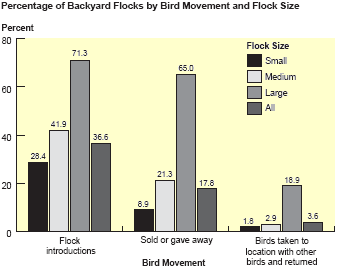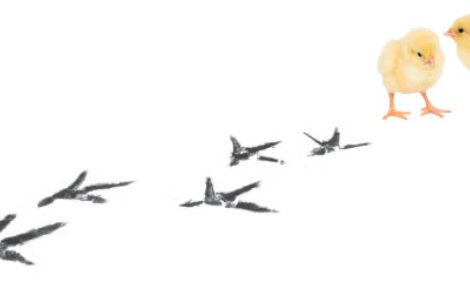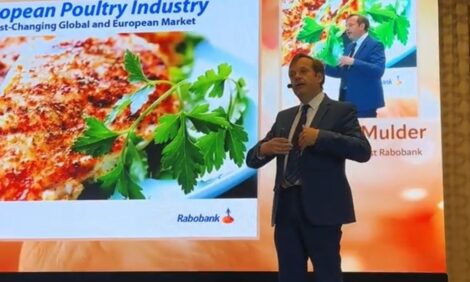



Highlights Poultry ’04 Part I: Reference of Health and Management of US Backyard/Small Production Flocks
By The National Animal Health Monitoring System - This article is a highlight of Part I of NAHMS's most recent study of the U.S. poultry industry.Introduction
Poultry ’04 is the National Animal Health Monitoring System’s (NAHMS) second study of the U.S. poultry industry. Layers ’99 was the first national study on poultry baseline health and management. Layers ’99 estimated the prevalence and associated risk factors of Salmonella enterica enteritidis in U.S. layer flocks. For Poultry ’04 NAHMS conducted a thorough assessment to determine the information needs of the poultry industry, researchers, and Federal and State governments. This needs assessment indicated a need for information regarding bird health, bird movement, and biosecurity practices of nontraditional poultry industries, such as backyard flocks, gamefowl, and live poultry markets.
Sampling circles
Data for Part I were collected via a questionnaire administered to owners of backyard flocks in 18 major poultry producing States (see map). A sample of large commercial poultry operations (n = 350) with at least 10,000 chickens or 5,000 turkeys was selected, and then a circle with a 1-mile radius was “drawn” around each of these selected operations. These circles were then canvassed for residences with birds other than or in addition to pet birds. A total of 349 of the 350 circles were canvassed. Over the 349 circles screened, there were 10,579 residences contacted, of which 156 had pet birds only and 763 had birds other than pet birds (backyard flocks). In addition, there were 668 commercial poultry operations (other than the ones selected to serve as the centers of the circles) within the 349 circles.
Bird types
Chickens of table-egg breeds were found in
two-thirds (63.2 percent) of backyard flocks and
accounted for 37.5 percent of all birds. Pet birds
accounted for only 0.3 percent of the total bird
population at residences with backyard flocks.
Gamefowl chickens were present in half the
backyard flocks (50.2 percent) in the Southeast
region and in only 4.1 percent of backyard flocks in
the East region. Guinea-fowl presence ranged from
4.3 percent of backyard flocks in the East region to
31.7 percent of backyard flocks in the Midwest
region.
On average, backyard flocks had 35.1 birds,
ranging from an average of 26.1 birds in the
Southeast region to 49.2 birds in the East region.
Nearly 1 in 3 backyard flocks (31.8 percent) had
fewer than 10 birds.
Bird health care
Use of a veterinarian’s services was rare in
backyard flocks (2.9 percent of backyard flocks
overall). As flock size increased, the percentage of
backyard flocks that used a veterinarian’s services
increased.
Vaccinations were given by only 2.8 percent of
backyard flocks. Administration of vaccines
increased as flock size increased.
External parasites were the most common
health problem reported (5.5 percent of backyard
flocks). In general, reported health problems
increased as flock size increased. Nearly onefourth
of large backyard flocks (21.4 percent)
reported respiratory problems.
Feed stores were the most important healthinformation
source for backyard flocks (24.4
percent ranked feed stores very important). The
Internet was ranked very important by 9.7 percent
of backyard flock owners. The highest percentage
of large backyard flocks reported that other
producers and magazines/journals were very
important sources of bird health information, while
the highest percentage of medium and small
backyard flocks ranked feed stores as very
important.
About half of backyard flocks found bird health
care products and services readily available.
Backyard flocks in the Southeast region reported
the most difficulty obtaining products/services.
Small flocks reported more difficulty obtaining
products/services (especially medications)
compared to large flocks.
Ponds and bird feeders
Ponds that attract wild waterfowl were present on the property of 38.4 percent of backyard flocks, ranging from 64.6 percent in the Midwest region to 24.7 percent of backyard flocks in the Southeast region. Over half the backyard flocks (52.4 percent) that raised domestic waterfowl had a pond on the property that attracted wild waterfowl. Wild bird feeders were on the property of 40.0 percent of backyard flocks.
Bird movement
The percentage of backyard flocks that had one
or more introductions of new birds during the
previous 12 months ranged from 28.3 percent in
the Southeast region to 51.7 percent in the Midwest
region and 36.6 percent overall. The majority of
backyard flocks with new flock additions (60.0
percent) obtained the new birds from within their
same county.
Overall, 17.8 percent of backyard flocks sold or
gave away live birds in the previous 12 months.
Movement of birds from backyard flocks increased
as flock size increased, with 65.0 percent of large
flocks selling or giving away live birds.
Only 3.6 percent of backyard producers moved
birds to locations where other birds were present
(such as fairs, shows, etc.). Most producers who
took birds to shows, etc., and returned them to their
flocks went to events that were within their county
or State.

Mortality
Just over half of all backyard flocks (55.2 percent) had at least one bird death (other than birds slaughtered for human consumption) during the previous 12 months. Bird death loss during the previous year was 10.8 percent. Burial on the premises was the most common method of disposing of dead birds.
Producer characteristics
The most common reason for having birds was for fun/hobby, which ranked very high for 40.6 percent of backyard flocks. About one in four producers ranked family tradition, food, and lifestyle very high as reasons for having birds. Overall, very few backyard flocks (3.5 percent) had someone in the household who worked for a commercial poultry operation, ranging from 0.9 percent of backyard flocks in the Southeast region to 8.5 percent of backyard flocks in the Midwest region.
Further Information
To read the full report, please click here (91 page PDF)
Source: Animal and Plant Health Inspection Service - June 2004








